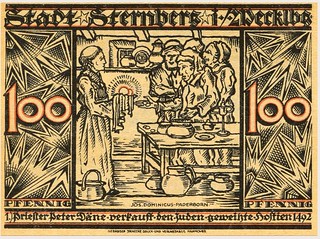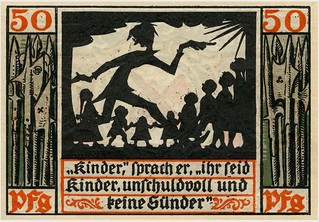
PREV ARTICLE
NEXT ARTICLE
FULL ISSUE
PREV FULL ISSUE
GERMAN NOTGELDPablo Hoffman passed along this excellent article from Topic magazine about German WWI emergency money. Thanks. Here's an except. See the complete article online for much more. -Editor
In 1914, as Germany entered into World War I, the country suspended its gold standard, temporarily halting the exchange of paper marks for gold to prevent a run on the banks. No longer tethered to gold, the value of Germany's paper currency began to inflate, and scared German citizens began to hoard coinage. As a result, the raw metal worth of a 50 pfennig or 2 mark coin quickly outstripped its face value. (Nickel and copper could be used in the growing military industry.) The German economy ran on these coins: a shirt might cost 5 marks, a pair of shoe soles, 3.75. So the sudden withdrawal of coinage precipitated a severe currency shortage—all within the first few months of the war. Throughout the country, cities and financial institutions had no choice but to get creative. Enter notgeld ("emergency money"), whose purpose was to paper over the shortages in circulating currency. This new kind of money was never authorized by any central or state bank; it was local governments and banks, as well as employers, that introduced notgeld as a short-term, stopgap measure, a temporary currency with a fixed expiration date that functioned more or less as an IOU. Anything could be recycled into notgeld: tickets, cardboard stock, whatever was lying around. The goal was simply to keep something in circulation that could be used for goods and services so the German economy didn't fall apart. Germany wasn't the first country to experiment with notgeld; DIY currency has been used in times of crisis throughout history. During the Civil War in the United States, postage stamps encased in brass were accepted as legal tender in the North during a coin shortage that lasted throughout the war. In 1685, when Canada was still part of France, the colony experienced a shortage of French coinage and soldiers threatened mutiny if the government delayed payments to them. In response, finance minister Jacques de Meulles rounded up every deck of playing cards he could find and reissued them as temporary currency. (Germany, too, used the playing-card trick during World War I, creating "spielkarten," currency made from cut-up playing cards stamped with numerals to indicate value.)
To read the complete article, see: 
Wayne Homren, Editor The Numismatic Bibliomania Society is a non-profit organization promoting numismatic literature. See our web site at coinbooks.org. To submit items for publication in The E-Sylum, write to the Editor at this address: whomren@gmail.com To subscribe go to: https://my.binhost.com/lists/listinfo/esylum All Rights Reserved. NBS Home Page Contact the NBS webmaster 
|

